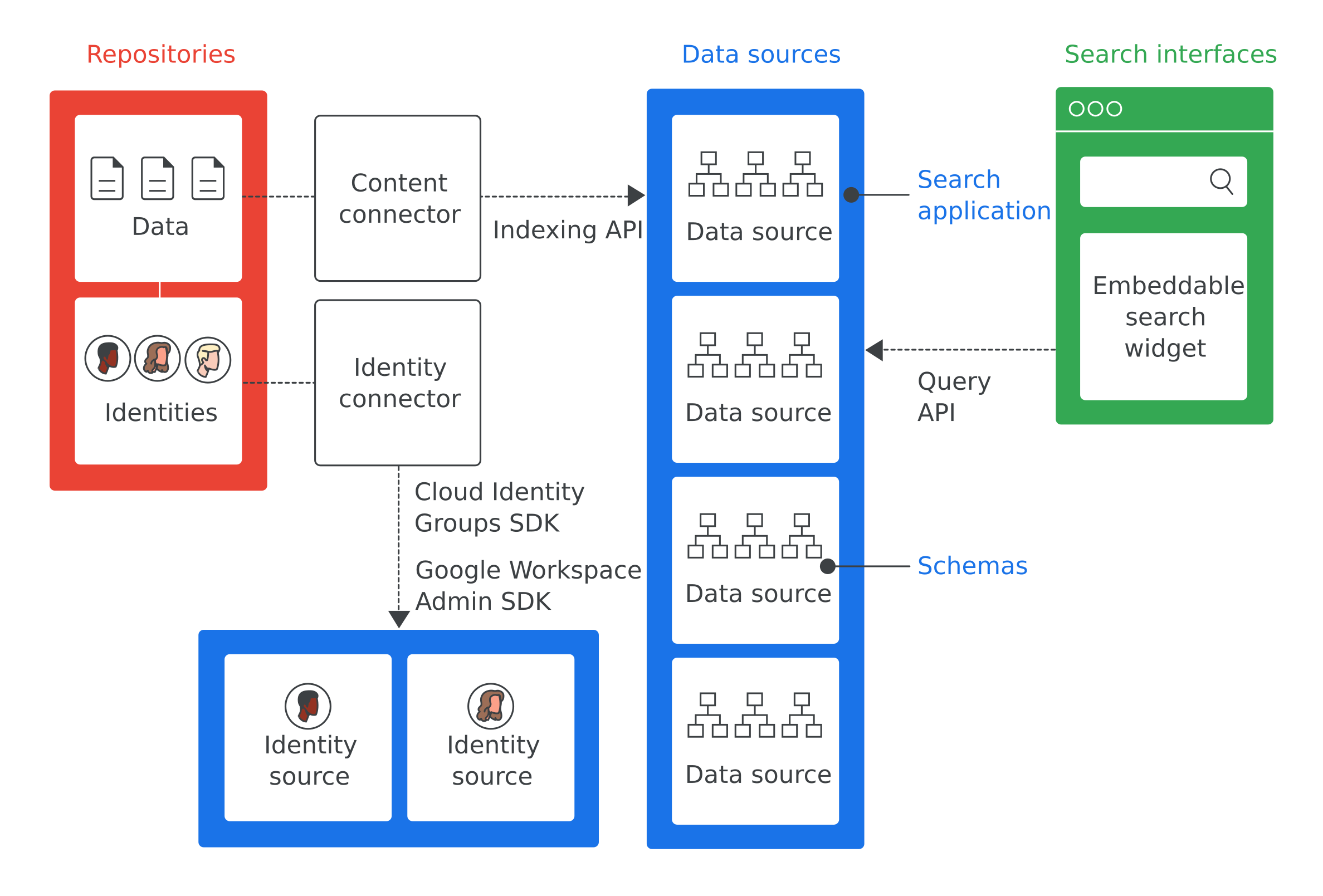Google Cloud Search 可让公司员工从公司的内部数据存储区中搜索和检索内部文档、数据库字段和 CRM 数据等信息。
架构概览
图 1 显示了 Google Cloud Search 实现的所有重要组成部分:

以下是图 1 中涉及的几个最重要术语的定义:
- 代码库
- 企业用来存储其数据的软件,例如,用于存储员工信息的数据库。
- 数据源
- 存储区中已编入索引并存储在 Google Cloud Search 中的数据。
- 搜索界面
- 员工用来搜索数据源的界面。您可以自行开发适用于任何设备(无论是移动电话还是桌面设备)的搜索界面。还可以部署 Google 提供的搜索微件,以便在您的内部网站中实现搜索功能。每次搜索都包含搜索应用 ID,以确保了解该搜索的上下文(例如在客户服务工具中)。cloudsearch.google.com 网站包含一个搜索界面。
- 搜索应用
- 一组设置;当与搜索界面关联时,这组设置提供有关搜索的上下文信息。上下文信息包含使用该界面进行搜索时应使用的数据源和搜索排名。搜索应用还可提供结果过滤机制以及数据源相关报告,例如在给定时间段内执行的查询数。
- 架构
- 一种数据结构,用于说明如何针对 Google Cloud Search 表示企业存储区中的数据。架构决定了员工的 Google Cloud Search 体验,例如内容的过滤和显示方式。
- 内容连接器
- 一种软件程序,用于遍历企业存储区中的数据并填充数据源。
- 身份连接器
- 用于将企业身份(用户和群组)同步到 Google Cloud Search 所需的身份的软件程序。
Google Cloud Search 用例
以下是 Google Cloud Search 适用的一些用例:
- 员工需要以某种方式查找公司政策、文档和由其他员工编写的内容。
- 客户服务团队成员需要查找相关问题排查文档以发送给客户。
- 员工需要查找与公司项目有关的内部信息。
- 销售代表需要查看特定客户的所有支持问题的状态。
- 员工需要查看公司特有术语的定义。
要实现 Google Cloud Search,首先需要确定 Google Cloud Search 所适用的用例。
实现 Google Cloud Search
默认情况下,Google Cloud Search 会将 Google Workspace 数据(例如 Google 文档和电子表格)编入索引。Google Workspace 数据不需要实现 Google Cloud Search。但是,非 Google Workspace 数据(如存储在第三方数据库中的数据)、文件系统(如 Windows Fileshare、OneDrive)或内网门户(如 Sharepoint)则需要实现 Google Cloud Search。要为您的企业实现 Google Cloud Search,您需要按以下步骤操作。
- 确定可借助 Google Cloud Search 解决的用例。
- 确定用于保存用例相关数据的存储区。
- 确定您的公司用于管理对各存储区中数据的访问权限的身份系统。
- 配置对 Google Cloud Search API 的访问权限。
- 将数据源添加到 Google Cloud Search。
- 为每个数据源创建一个架构并进行注册。
- 确定是否有可用于您的存储区的内容连接器。 如需获取预建连接器的列表,请参阅 Cloud Search 连接器目录。如果有可用的内容连接器,请跳至第 9 步。
- 创建内容连接器,以访问各存储区中的数据并将其编入 Cloud Search 数据源的索引中。
- 确定您是否需要身份连接器。如果您不需要身份连接器,请跳至第 11 步。
- 创建身份连接器,以将您的存储区或企业身份映射到 Google 身份。
- 设置搜索应用。
- 创建搜索界面以执行搜索查询。
- 部署连接器和搜索界面。如果您使用了预构建连接器,请按照连接器的说明获取和部署连接器。如需了解可用的连接器,请参阅 Google Cloud Search 连接器目录。
后续步骤
您可以将以下几个步骤作为后续步骤:
- 试用 Google Cloud Search 入门教程。
- 确定 Google Cloud Search 将被用于的用例。
- 确定与这些用例相关的存储区。
- 确定您的存储区使用的任何身份系统。
- 继续配置对 Google Cloud Search API 的访问权限。
